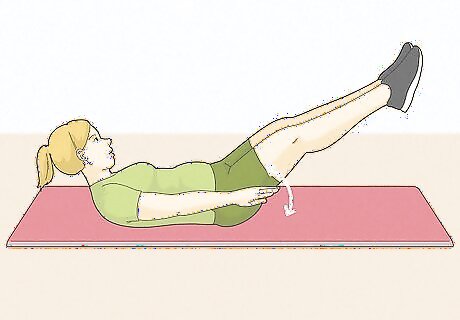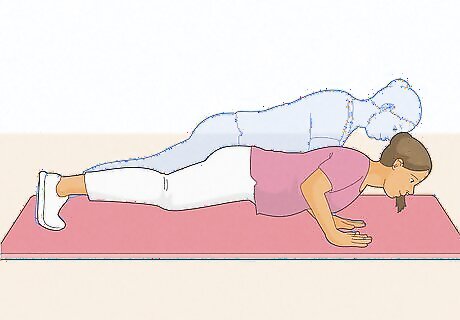
views
- Lose belly fat and tighten the skin on your abs with full-body workouts as well as targeted exercises, like squats and crunches.
- To get rid of excess fat, eat about 500 fewer calories a day, eat lean protein, and stay hydrated.
- To tighten the skin on your stomach, try topical firming creams or medical procedures such as radio frequency treatment or plastic surgery.
Exercises to Reduce Stomach Fat

HIIT HIIT, or high-intensity interval training, refers to an exercise routine alternating short bursts of intense anaerobic exercise with brief recovery periods. The exercises in a HIIT workout vary, but they often include jump-roping, sprinting, planking, burpees, or squats. They’re quick, effective, and free (since you usually don’t need any equipment), and you can often do them in a small space, like your living room. If you're struggling with extra tummy fat after giving birth, don't jump right into intensive workouts, especially ones that engage your abdominal muscles (like crunches or planks), until a couple of months have passed—your body has just been through a lot, and it needs time to rest and heal. You can take HIIT classes in your area, or you can do HIIT training at home for free: YouTube includes a number of effective HIIT workouts of varying lengths and experience levels, so you can find one that works for you and pause if you need to. If you’re strapped for time, HIIT is one of your best bets: its high intensity means that the workout usually only lasts between 10-30 minutes, but you still get the benefits of a longer workout. In fact, studies indicate HIIT workouts burn 25-30% more calories than other workouts do.

Squats Squats are a perfect exercise to engage not only your abs, but your glutes, thighs, and calves. Plus, they’re easy to do basically anywhere, since they don’t take up much space and they don’t require any equipment. To do a squat, stand with your feet about shoulder-width apart. Slowly lower your upper body by bending your hips and knees, until your thighs are parallel to the ground (if you can’t do this on the first go, don’t try to force it!). Pause for a beat and then rise again. Repeat this action 10 to 20 times.

The hundred Pilates is known to be effective at strengthening abdominal muscles and toning the stomach. The hundred is just one example of a Pilates exercise that won’t only engage your core, but your entire body, meaning it won’t just help you tone those belly muscles, it’ll target muscles all over your body. To do the hundred, just lie on your back with your knees bent and your feet flat on the floor, with your arms outstretched at your sides. Then, holding your legs together, extend your legs and raise them up, so that your feet are a few feet off the ground. Lift your upper back and chest to engage your abs. With your knees, upper back, and chest lifted the whole time, repeatedly raise your arms—keeping them straight, fingers outstretched—about an inch up off the floor. Pump your arms up and down about a hundred times before relaxing your body and hugging your knees for a few seconds. Repeat this 2 or 3 times if you can.

Jackknife crunches Regular crunches may help tone your belly and strengthen your muscles, but they’re unlikely to help you lose weight unless you engage the whole body. The jackknife crunch helps solve that problem! This is another popular Pilates move that can help you tone your belly while giving you a great full-body workout that’ll help you shed pounds. This move engages your lower abdomen while giving your legs and arms a great workout of their own. To do a jackknife crunch, lie flat on your back with your legs bent at a 90-degree angle and your arms fully extended above your head. Engage your abdominal muscles as you lift your legs—straightening them as you lift—and your arms—keeping them straight. Try to touch your knees with both hands (but don’t force it if your body doesn’t want to move that way, especially at first). Lower your arms and legs to about an inch above the floor, and repeat this movement about 20 times, then rest.

Push-ups Push-ups are a classic for a reason. They’re a great way to tone your abdominal muscles and tighten the skin on your lower belly, while also strengthening the rest of your body. And the best part is push-ups are easily modified to suit your skill level—for instance, by dropping your knees to lessen the amount of weight you’re lifting or doing inclined push-ups against a wall or countertop. To do one push-up, get down on all fours, with your knees about hip-width apart and your hands slightly wider than your shoulders. Then, straighten your legs and arms. Bend your elbows to lower your body until your chest almost touches the floor. Pause for a beat, then lift yourself up again. Repeat this movement 10 to 20 times.

NEAT NEAT stands for Non-Exercise Activity Thermogenesis, and it refers to any activity that gets you up and moving, even if it’s not technically a “workout.” A NEAT activity could be walking to work instead of driving, playing with your kids, mopping the floor, raking leaves—basically, it’s a way to sneak physical activity into your daily routine beyond dedicating specific time to going to the gym or jumping on the treadmill. NEAT doesn’t have to mean walking 3 hours to your office each day—it might mean bussing halfway and walking the remainder of the trip, or driving the whole way but taking the stairs to your floor instead of the elevator. A quick 15-minute walk is a great way to begin your day, take a break in the afternoon, or help your stomach digest after dinner. A 15-minute walk might not feel like a lot, but multiple little walks add up! To engage your ab muscles more while walking, try marching.
Dietary Changes for Losing Belly Fat

Enter a manageable calorie deficit. One of the best ways to lose fat all over is by cutting calories. While drastically reducing your calories might give you quick results, it’s not really a sustainable or healthy method for losing weight, so it’s important to enter a consistent, manageable calorie deficit you can keep up over time—even if it means you don’t shed those pounds as fast as you’d like. Aim for about 500 fewer calories per day than you usually consume. The average person needs about 2000 calories to maintain their weight, so in order to lose weight, try to get about 1500 calories a day. If you’re a woman, be sure not to go lower than 1200, and if you’re a man, don’t get fewer than 1500. Try food tracker apps like My Fitness Pal or LifeSum to record roughly how many calories you’re getting every day. Food tracker apps can be useful for some people, but they may be triggering to those who struggle with disordered eating. If you feel that tracking your calorie count isn’t helpful, avoid the apps, and just try to be aware of what you’re eating throughout the day.

Eat more protein. While cutting calories can help you slim down, if you’re not eating enough protein, you may struggle to lose “skinny fat”—in other words, you might be slender, but lack muscle tone. Try to eat a minimum of about 0.8 grams of protein per kilogram of body weight (or 0.36 grams per pound) every day, and ensure about 35% of your daily caloric intake comes from protein. For example, if you weighed 140 pounds, you’d multiply 140 by .36 and get 50.4 grams of protein. In kg, you’d multiply 63.5 kg by .8 and get 50.8. If you want to skip the math, input your info into the USDA's DRI (dietary reference intake) app to calculate calculate exactly how much protein you need based on your body type. Stock up on delicious plant-based proteins like edamame, tofu, almond milk, seitan, quinoa, lentils, and peanut butter, or animal-derived proteins like turkey, salmon, cheese, eggs, and yogurt.

Stay hydrated. Water can help you stay energized, suppress your appetite, and boost your metabolism, all of which can help you lose weight. Be sure to drink plenty of water throughout the day: women need about 11.5 cups (92 ounces) of water a day while men need about 15.5 cups (124 ounces). Note that you can reach your daily recommended amount of water with other beverages—not just plain water. Go for unsweetened tea, coffee, sparkling water—even the occasional sugary drink or alcoholic beverage (just try not to overdo it!). Often, what feels like hunger is really dehydration, so the next time you feel like grabbing a snack, drink a glass of water first; if you’re still hungry after, grab a snack.

Practice mindful eating. It’s easier to gain weight when we’re not conscious of what or why we’re eating. Mindful eating asks us to focus on the experience of eating, including our bodily sensations while we eat and our thoughts and feelings about food, without judgment. “Dieting” can feel like a major chore, but the goal of mindful eating is to enjoy eating, and to better understand how to nourish your body. Counting calories can help you lose weight, but only focusing on calorie content can distance you from the experience of eating your food. When you practice mindful eating, you also focus on your body’s internal and external hunger cues and your response to those cues.
Lifestyle Changes to Reduce Belly Fat

Reduce stress. Many of us are “emotional eaters,” and stress is one delicious emotion, unfortunately. If you’re struggling with stress, it might influence you to overeat or to go for the wrong foods, which can lead to excess weight gain. If you can, take steps to minimize your stress to make it easier to adhere to a healthy diet. Conveniently, exercising doesn’t just burn fat—it also reduces stress! Regular physical activity can help lift your spirit, boost your confidence, and alleviate stress. Talking to friends about personal struggles or seeing a licensed counselor may also help alleviate stress.

Get quality sleep. The average adult needs about 8 hours of uninterrupted sleep each night. When you’re tired, you’re more likely to be irritable and to give into emotional eating as well as lack the motivation and energy to exercise. Try to get some quality Zs every night to ensure you feel great the next day. To get better quality sleep, be sure to go to bed at the same time each night and eliminate any distractions, like screens (especially screens with blue light).
Tightening Loose Skin

Topical creams Prescription or over-the-counter topical skin-tightening creams, lotions, and serums may help with minor skin sagging. Look for products with collagen and retinol, which help improve elasticity, or talk to your doctor about your prescription options.

Limited sun exposure Staying out of the sun and using a high SPF lotion (at least SPF 30) when you do go out can help reverse the effects of loose skin. Excessive sunlight can dry out your skin and decrease collagen levels, leaving your skin prone to sagging and wrinkling. But avoiding the sun and using proper UV protection can ensure your body is able to produce healthy new skin cells, which can make your lower stomach tighter.

Radiofrequency treatment During radiofrequency skin tightening, an electromagnetic device is used to produce new skin cells as well as collagen and elastin—proteins that make your skin strong and flexible. The procedure improves skin tone and smooths and tightens wrinkled or sagging skin. The effects of radiofrequency typically last 1 to 3 years.

Laser resurfacing treatment Similar to laser therapy, laser resurfacing treatment uses a pulsating light to vaporize layers of skin. As the lasers remove the epidermis (the outer layer of skin), they heat the layer underneath (the dermis), stimulating new collagen growth, which makes the skin tauter. For only moderately loose skin, you may opt for laser therapy, which only heats the surface layer of skin to promote collagen growth and doesn't remove any existing skin.

Tummy tuck If you have a lot of loose skin, plastic surgery may be an option. During a tummy tuck, excess skin and fat are removed from the stomach, and the remaining skin is then repositioned for a smoother, more toned appearance. If you’re dealing with loose abdominal skin after a C-section, your surgeon might be able to incorporate your tummy tuck scar into your existing C-section scar.




















Comments
0 comment